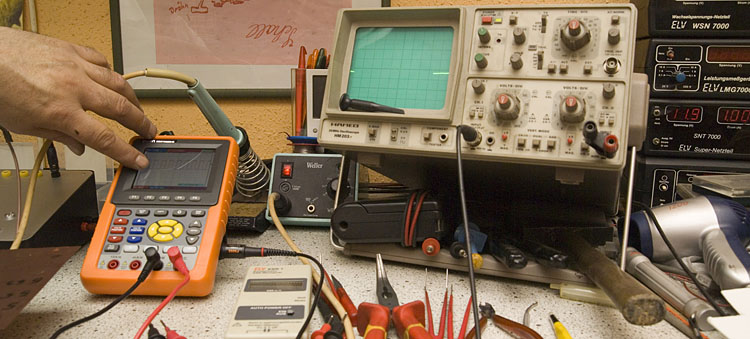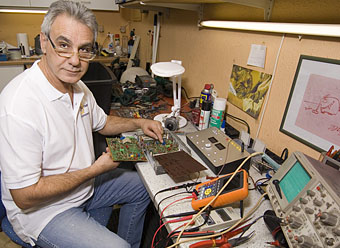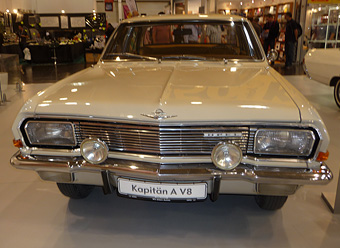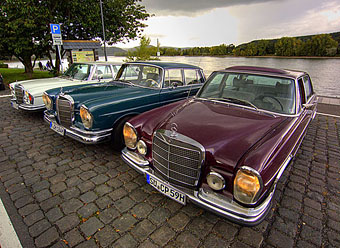Diagnostics
He who loves his car, which pushes or better - he likes it.
Like everything with which we surround ourselves, a motor vehicle expected a reasonable and solid care. Who runs his beloved vehicle in the winter and it does not exempt the very latest in spring from road salt, must not be surprised if it wegrostet him under the ass. So it is also with the maintenance of the vehicle under the hood. Consider but note that our vehicles have 40 years and more under their belt and have thus already brought four average car life behind.
Procedure for troubleshooting and explaining the functions of the components and sensors. Are described here components that were installed in our Mercedes-Benz 300 SEL 3.5, built in 1970.
Similarly, the different pressure and vacuum data relate primarily to our vehicle. Therefore there may be other vehicles deviations:
When troubleshooting in D-Jetronic systems you should take a systematic approach for simplicity. The senseless time here turn off and adjust something there is no point in the rule. The opposite is the case and I guess as far as possible from it.
Fuel pressure:
First, the fuel pressure should always be checked. For this purpose, a standard pressure gauge with a scale up to 6 bar is. In some forums circulating the opinion that there must necessarily be a glycerine damped pressure gauge, possibly a matter of philosophy.
Similarly, always bypass line is named for the cold start valve as an ideal test location.
People, be especially careful here and let it dear.
Each point in the loop is equally well suited to measure the fuel pressure. The cold start valve is at the top of a plastic cap. By Disconnecting and reconnecting the fuel line they can break easily. In addition, the cold start valve can losrappeln and then to the motor housing back no longer sealed. The piece is indeed as old as the rest of the vehicle.
The fuel pressure should incidentally exactly 2.0 bar + max. 0.1 bar; but never -0.1 bar.
It is often described namely 2.0 bar +/- 0.1 bar. This statement is definitely wrong.
Electric fuel pump (EKP):
The EKP is a roller vane pump and initially test for running noise, only electrically and mechanically. The flow rate should be 1 liter in 30 seconds, measured on the return.
Fuel pressure regulator (SDF):
The fuel pressure regulator has two ports. The two sides are used in the loop and are therefore within the circuit of the fuel pressure line. At the bottom of the return pipe is connected to the fuel tank. The fuel pressure regulator is a largely wear-free component.
Pulsation dampers or pressure pulse damper:
In some forums it is considered appropriate that we in our vehicles a pulsation damper (Audi 100) installed. This damper is to prevent foaming of the fuel. This statement is not entirely correct. The pulsation damper has only one sound-absorbing effect.
Injectors:
Please always use exactly the valves that Bosch has also provided for the vehicle to which it is here. Injectors are usually by a colored ring, as well as in Bosch numbers.
Ring color = different flow rates
Replicas are always marked by a gray ring.
Although the cleaning of injectors in the ultrasonic bath is a good approach, but does so nothing. The valves shall simultaneously with a pulsed DC voltage of max. 3 volts is controlled so that the needle moves in the valve stem guide back and forth and so also encrustations can be dissolved and flushed out within the valve stem guide.
Please never closes a fuel injector simply permanently on 3 V DC voltage. The internal solenoid winding does not like that and would dissolve after a short time in smoke.
Injectors should always be cleaned with test oil and tested by comparing measurements after test instructions.
The coils of the injectors should have a resistance of 2 at an ambient temperature of + 20 degrees Celsius - have 3 ohms.
Pressure sensor (SDF):
The Saugrohrdruckfühler sitting on most of our cars on the front wall transversely under the windshield. He is extremely sensitive to vibration and therefore mounted on rubber feet. Therefore, while sending a pressure sensor huge emphasis must be placed on a shock-resistant packaging.
Also applies to the pressure sensor, as with all control elements of the D-Jetronic:
BOSCH PARTS ONLY USE THE EXACT ALSO FOR THIS VEHICLE IN THE ORIGINAL EQUIPMENT WERE USED WERE.
The pressure sensor is connected electrically with a 4-pin connector. The two outer pins are labeled 7 and 15 (primary coil), the two inner pins are labeled 8 and 10 (secondary coil). Thus, it does not matter how the plug is plugged in, a twist of the plug has no effect on the function of the pressure sensor.
Pressure sensor with a black patch cap have a height correction. These pressure sensors were installed only in vehicles that were exported to the United States or Switzerland. This pressure sensor offers two doses membranes, wherein the vacuum and the other against a working against the atmospheric pressure. In return at this pressure sensor eliminates the full-load enrichment.
Both pressure sensors can with low pressure of max. 500 mbar to be tested. The coil resistance of the primary winding should be 80 to 120 Ohms. The coil resistance of the secondary winding should be 300-400 Ohms. Further measurements (inductance) are possible only with a oscilloscope or a Induktivitätsmessgerät.
Additional air slide (ZLS):
The auxiliary air slide in our cars is a purely mechanical device.
It is mounted so that its lower part projects into the cooling water circuit. In that the lower part sits an expansion element which expands with increasing heat.
He has a connection for the air intake, as well as a connection for the air outlet. Between these two terminals is located, the control piston presses against a compression spring. Expands the expansion element, the piston is pushed against the spring force of the compression spring up and closes the air passage between the inlet and the outlet from almost complete. More specifically, it should be closed at a temperature of 60 degrees Celsius to 95%. But it should not completely close.
The auxiliary air slide has a bypass function for throttle. He is the engine speed stabilize or increase slightly in the cold run.
Cold start valve:
The cold start valve is clocked briefly during startup and an ambient temperature below 35 degrees Celsius. The cold start valve has a 2-pin electrical connector. It sits on a branch in the gasoline leader loop. When controlling the internal solenoid coil is energized briefly and attracts an armature. By tightening of the armature, the fuel can flow and thus enters the combustion chamber of the engine by the passage of the cold start valve. The seal of the cold start valve must be resistant 100%, otherwise extra gasoline would constantly get into the combustion chamber of the engine. The coil of the cold start valve should have a resistance of 4.2 ohms.
Distributor with injection timer:
The distributor of our vehicles consists of the following components:
At the vacuum unit, a thin tube is attached. Watch here please on both sides tightness of the hose.
The contacts of the injection triggers are mounted on a semi-circular support which is reminiscent of a bite. Many refer to this as the trigger bit.
Some support plates are equipped with additional felt, which should be regularly cleaned and greased. The contacts should be clean and checked for contact erosion. They are responsible for the control of the injectors.
Throttle switch:
The throttle switch consists of 4 or 5 grinders which grind on contact paths on the underlying circuit board. At idle, it should be closed.
At a deflection of the throttle greater than 1 degree (about 0.4-0.5mm) he should be open. For slow passage of the gas pedal, or, slow actuation of the throttle valve by hand the gauge display has 10 times between 0 and infinity ohms, so commute closed and open line. The reason is that the idle switch grinds over a sawtooth trace which the contact interrupts again and closes.
Of the throttle valve switch is responsible for the acceleration enrichment, the idle and full load control.
In other words, full load increase, fast idle, transition enrichment.
To adjust the throttle valve and the throttle valve switch, it is best to proceed as follows:
The stop screw out until the throttle is released. Then the screw until reindrehen until it rests against the throttle. Finally, to half a turn reindrehen a quarter on. If the motor saws idle, turn the screw back minimal.
The screws on the throttle switch solve and connect a multimeter. Directly to the throttle switch perform a resistance measurement. The value must be 0 ohms, the throttle valve is deflected to a degree, the idle switch must be open. Each tick mark on the throttle body is 2 degrees deflection. Set the throttle switch so that it opens deflection at 1 degree. Check again after the successful setting. When the deflection of one degree, the switch must be open.
Air temperature sensor (NTC 1):
He sits across the front of the snorkel of the air filter housing and measures the ambient temperature. This measurement and control variable is fed to the control unit to PIN 1.
NTC stands for: Negative Temperature Coefficient thermistor.
So he heads better than at low temperatures at high temperatures electricity.
Here is the table for the air temperature sensor:
Measured at the sensor.
Temperature sensor for cooling liquid (NTC 2):
It is installed on the engine, that it projects with its sensor in the coolant circuit. It measures the coolant temperature. This measurement and control variable is fed to the control unit.
Here is the table for the temperature sensor Coolant:
Measured at the sensor.
Controller:
Common solid workmanship, carefully selected electronic components and a full metal housing which houses the art form, the "brain" of the D-Jetronic.
In many vehicles it is behind the glove compartment, hidden behind respectively the floorboards of the passenger and done there usually harmless its service. In our vehicle (W109), it is the front, standing in front of the vehicle, installed behind the left headlight.
Most of the aforementioned sensors and actuators report their values to the controller. This evaluates them, and regulates accordingly.
The controller is a purely analog electronic component, which still operates entirely without microprocessors, chips and the like. These analogs technique is mastered only by very few specialists. Our vehicles do not have a connection for a test computer (OBD or On Board Diagnostics), here's a real thinking hip.
If an error in the D-Jetronic not found, this ominous black box is usually identified as perpetrators, wrongly, I think.
Yet one should not forget that there is a component with many hundreds of solder joints and almost 60 transistors. These control devices have now almost half century under his belt.
Cold solder joints, defective transistors and diodes are commonplace.
Who wants to do its controller something good, it can be overhauled in the cold and wet season. In this season of classic car sleeps in the garage anyway.

The next spring comes but determined. Since it is a good feeling to know that the sensitive electronic heart beats again with full force.
Impressions





